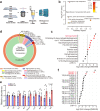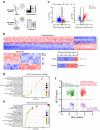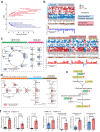SETD2 deficiency accelerates sphingomyelin accumulation and promotes the development of renal cancer
- PMID: 37989747
- PMCID: PMC10663509
- DOI: 10.1038/s41467-023-43378-w
SETD2 deficiency accelerates sphingomyelin accumulation and promotes the development of renal cancer
Abstract
Patients with polycystic kidney disease (PKD) encounter a high risk of clear cell renal cell carcinoma (ccRCC), a malignant tumor with dysregulated lipid metabolism. SET domain-containing 2 (SETD2) has been identified as an important tumor suppressor and an immunosuppressor in ccRCC. However, the role of SETD2 in ccRCC generation in PKD remains largely unexplored. Herein, we perform metabolomics, lipidomics, transcriptomics and proteomics within SETD2 loss induced PKD-ccRCC transition mouse model. Our analyses show that SETD2 loss causes extensive metabolic reprogramming events that eventually results in enhanced sphingomyelin biosynthesis and tumorigenesis. Clinical ccRCC patient specimens further confirm the abnormal metabolic reprogramming and sphingomyelin accumulation. Tumor symptom caused by Setd2 knockout is relieved by myriocin, a selective inhibitor of serine-palmitoyl-transferase and sphingomyelin biosynthesis. Our results reveal that SETD2 deficiency promotes large-scale metabolic reprogramming and sphingomyelin biosynthesis during PKD-ccRCC transition. This study introduces high-quality multi-omics resources and uncovers a regulatory mechanism of SETD2 on lipid metabolism during tumorigenesis.
© 2023. The Author(s).
Conflict of interest statement
The authors declare no competing interests.
Figures







Similar articles
-
Multilevel Regulation of β-Catenin Activity by SETD2 Suppresses the Transition from Polycystic Kidney Disease to Clear Cell Renal Cell Carcinoma.Cancer Res. 2021 Jul 1;81(13):3554-3567. doi: 10.1158/0008-5472.CAN-20-3960. Epub 2021 Apr 28. Cancer Res. 2021. PMID: 33910928
-
Functional Studies on Primary Tubular Epithelial Cells Indicate a Tumor Suppressor Role of SETD2 in Clear Cell Renal Cell Carcinoma.Neoplasia. 2016 Jun;18(6):339-46. doi: 10.1016/j.neo.2016.04.005. Epub 2016 May 26. Neoplasia. 2016. PMID: 27292023 Free PMC article.
-
Loss of SETD2, but not H3K36me3, correlates with aggressive clinicopathological features of clear cell renal cell carcinoma patients.Biosci Trends. 2017 May 23;11(2):214-220. doi: 10.5582/bst.2016.01228. Epub 2017 Mar 6. Biosci Trends. 2017. PMID: 28260718
-
The roles of chromatin-remodelers and epigenetic modifiers in kidney cancer.Cancer Genet. 2015 May;208(5):206-14. doi: 10.1016/j.cancergen.2015.02.008. Epub 2015 Feb 20. Cancer Genet. 2015. PMID: 25873528 Free PMC article. Review.
-
BAP1, PBRM1 and SETD2 in clear-cell renal cell carcinoma: molecular diagnostics and possible targets for personalized therapies.Expert Rev Mol Diagn. 2015;15(9):1201-10. doi: 10.1586/14737159.2015.1068122. Epub 2015 Jul 11. Expert Rev Mol Diagn. 2015. PMID: 26166446 Review.
Cited by
-
Small Extracellular Vesicles with a High Sphingomyelin Content Isolated from Hypertensive Diabetic db/db Mice Inhibits Calcium Mobilization and Augments Amiloride-Sensitive Epithelial Sodium Channel Activity.Biology (Basel). 2025 Mar 1;14(3):252. doi: 10.3390/biology14030252. Biology (Basel). 2025. PMID: 40136509 Free PMC article.
-
NSD2 promotes cell durotaxis and drives the transition from polycystic kidney disease to tubulocystic renal cell carcinoma through integrin/FAK/AKT signaling.Oncogene. 2025 Jul 22. doi: 10.1038/s41388-025-03505-x. Online ahead of print. Oncogene. 2025. PMID: 40696168
-
Immunogenic shift of arginine metabolism triggers systemic metabolic and immunological reprogramming to prevent HER2+ breast cancer.bioRxiv [Preprint]. 2024 Oct 26:2024.10.23.619827. doi: 10.1101/2024.10.23.619827. bioRxiv. 2024. Update in: Cancer Metab. 2025 Mar 20;13(1):15. doi: 10.1186/s40170-025-00384-4. PMID: 39484369 Free PMC article. Updated. Preprint.
-
Immunogenic shift of arginine metabolism triggers systemic metabolic and immunological reprogramming to suppress HER2 + breast cancer.Cancer Metab. 2025 Mar 20;13(1):15. doi: 10.1186/s40170-025-00384-4. Cancer Metab. 2025. PMID: 40114277 Free PMC article.
-
Emerging Approaches for Studying Lipid Dynamics, Metabolism, and Interactions in Cells.Annu Rev Biochem. 2025 Jun;94(1):417-446. doi: 10.1146/annurev-biochem-083024-110827. Epub 2025 Mar 18. Annu Rev Biochem. 2025. PMID: 40101206 Review.
References
Publication types
MeSH terms
Substances
Grants and funding
- T2122002/National Natural Science Foundation of China (National Science Foundation of China)
- 22077079/National Natural Science Foundation of China (National Science Foundation of China)
- 82203255/National Natural Science Foundation of China (National Science Foundation of China)
- 82372604/National Natural Science Foundation of China (National Science Foundation of China)
- 82073104/National Natural Science Foundation of China (National Science Foundation of China)
LinkOut - more resources
Full Text Sources
Medical
Molecular Biology Databases

